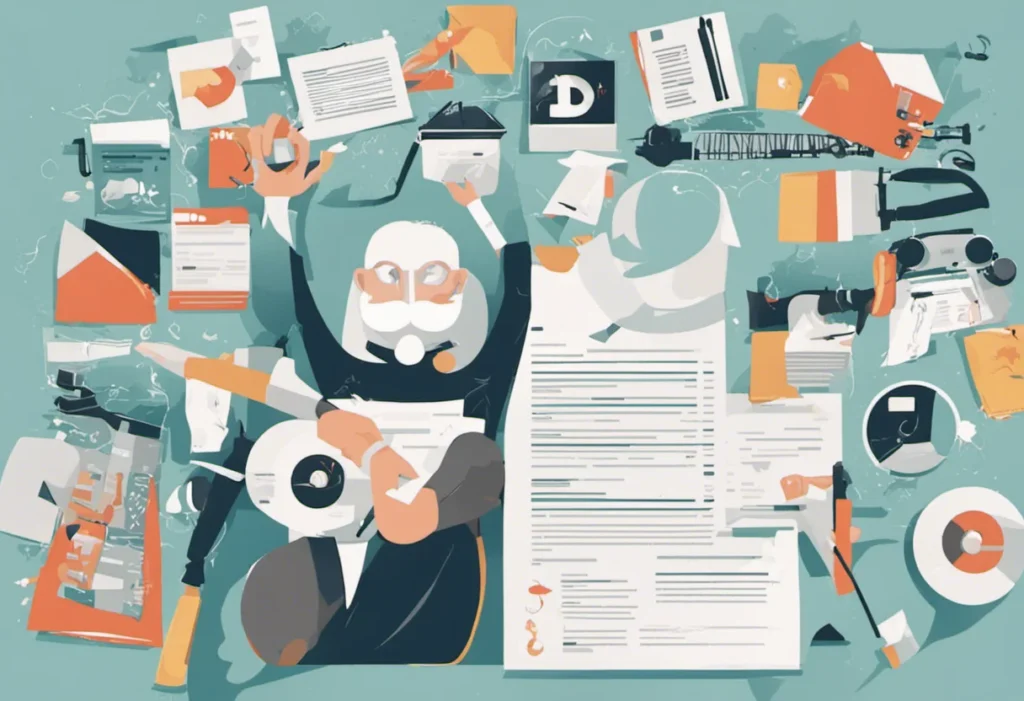Do you know ChatGPT uses a similar technology as ATS, which companies use to filter resumes? You can use ChatGPT to provide valuable insight for your resume. We will explore how to use ChatGPT to write a resume and how it can be used to improve your job application process.
In this article, we will cover everything you need to know to create a professional and tailored resume that aligns with industry standards and captures the attention of potential employers.
Key Takeaways:
- You can create a target and compelling document by understanding how ChatGPT works.
- ChatGPT can help you generate personalized resume templates and provide relevant content suggestions.
- Its language generation capabilities can be used to improve the tone, structure, and impact of your resume.
- It can increase your chances of impressing potential employers.
Let’s start with some per-processing and preparation before you start using ChatGPT
Initiating the Resume-Building Process:
- Identify your needs for a resume.
- Gather the required information such as the job role, company, and industry you’re targeting.
- Decide on the desired resume length (e.g., one or two pages).
- Identify key achievements and provide metrics for quantification.
- Inquire about ChatGPT’s requirements.
- Seek information from ChatGPT on the details it needs for optimal resume.

Gathering Required Information:
Here’s how to ensure ChatGPT has the necessary information and examples by considering these sources:
- Collect job descriptions for your target roles to provide ChatGPT with the necessary context. Get these descriptions from sources like official company websites, LinkedIn, Glassdoor, and Indeed.
- You can find professional resumes for references on Social media platforms like LinkedIn, Twitter, and Reddit.
- If available, use resumes of colleagues or classmates who have been shortlisted for similar roles as references.
- Conduct online searches on platforms like Google and Linkedin to locate credible resume references.
Structuring Your Resume:
To effectively use ChatGPT, you should provide the following sections in your resume:
- Header: Includes your name, current job title, and email.
- Education: Lists relevant degrees, institutions, locations, start-end dates, and any extra information to help ChatGPT understand your background.
- Experience: Includes start and end dates, company descriptions, and a narrative emphasizing skills and achievements.
- Certificates: Enumerate all relevant certifications.
- Technical Skills: Presented in a list format.
- Soft Skills: Highlighting outcomes achieved using these skills.
- Most Proud: Showcasing significant achievements.
- Various Resume Sections: Offering detailed insights into your experience.

Step-by-Step Guide On How to Use ChatGPT to Write a Resume:
- Start with your basic information: First, enter your Name, your Contact Information, and your professional experience (if applicable). ChatGPT will use this information to create a foundation for your resume.
- Add your skills: Enter your skills in the designated section. ChatGPT will ensure they are structured and presented correctly.
- Provide targeted job titles: Enter the job titles you want to apply for. ChatGPT will analyze your experience and skills, and use them to generate job-specific content.
- Choose a template: Pick a template that suits your style and preferences. ChatGPT offers a range of designs and formats to choose from.
- Use ChatGPT to generate content: Based on the information you’ve provided, ChatGPT will generate relevant content for your resume. If necessary, review and edit.
- Review your resume: Once your resume is complete, review it for any errors or inaccuracies. Ensure that it aligns with industry standards and showcases your skills.

Crafting Effective Prompts:
To maximize ChatGPT’s effectiveness in improving your resume, consider these pre-prompt tips:
- Be clear about your requirements, including tone and word count.
- Prepare a skills and education summary with essential background information.
- Provide all necessary details, such as job descriptions and specific accomplishments.
- Don’t hesitate to ask ChatGPT for guidance if you’re unsure about what information to provide.
Check Out Best 5 Free Prompt Engineering Courses & Resources 2023
Useful Prompt Templates:
Here are some templates for prompts when working with ChatGPT:
- Create a resume for [position] at [company] based on my skills summary.
- What keywords should I include for applicant tracking systems based on this job description? Give your resume and the job description to ChatGPT.
- Revise my resume for [JOB TITLE] at [COMPANY]. Give your resume and the job description to ChatGPT.
- Improve my resume for [position] at [company] by adding keywords from the job description and aligning it with the company’s values.
- summarize my work history into brief bullet points.
- Review my resume for improvements. Please provide feedback.
- Add metrics and achievements to my resume using this job description. Give your resume and the job description to ChatGPT.
- How can I make my resume stand out for this job?
- What keywords should I include for applicant tracking systems based on this job description?
- Make a specific section (e.g., skills, experience) on my resume more compelling.
- Rewrite my skills, experience, and achievements for [position] at [company].
- Add metrics and achievements to my resume using this job description. S
- Provide five ways to enhance these bullet points in my resume using this job description.
- Identify transferable skills for a career pivot to [JOB TITLE] at [COMPANY] using my resume and this job description.
Make sure your prompts include:
- The specific details job you’re applying for as clear and detailed as possible.
- Any length or formatting requirements.
- Relevant information about your skills and areas you want to emphasize.
- Desired Resume Templates.
- Bullet Points.
Bonus Tip: The more time invested in crafting precise prompts, the less time is required for resume editing.

Tips for Writing a Resume Using ChatGPT:
If you are new to ChatGPT for resume writing, you might need some tips to get started. Here are some valuable suggestions that can help you maximize ChatGPT’s potential and create an impressive resume.
- Be precise and to the point: When providing information about your work experience or skills, ensure that you are concise and avoid irrelevant details. ChatGPT evaluates the text and generates understandable words using natural language processing (NLP) methods. The more precise your information is, the more accurate the text generated will be.
- Use keywords: Hiring managers often screen resumes using keywords that match the job description. ChatGPT can assist you by suggesting relevant keywords based on your job description or industry. Include these keywords in your resume to increase your odds of getting noticed by employers.
- Edit and proofread: Although ChatGPT can generate text automatically, it’s still essential to review and edit the content manually. You can use tools like Grammarly to double-check the information for grammatical and spelling errors.
- Customize your resume: Don’t use using generic templates that don’t match your skills or experience. ChatGPT can assist you in creating personalized templates based on your input. Ensure that the template you choose showcases your strengths and highlights your achievements.
- Focus on achievements: Instead of listing your duties, highlight your achievements in your previous roles. ChatGPT can suggest relevant sentence structures that can help you frame your accomplishments better. This allows you to stand out from the crowd and show your value to employers.
- Be professional: Ensure your resume is well-structured and current with industry guidelines. ChatGPT will help you craft a language that’s relevant to your industry, avoiding jargon or informal language.
Refining the Output:
After receiving the resume generated by ChatGPT, undertake thorough review and editing. Execute the following steps:
- Review for grammatical errors and typos using tools like Grammarly or WordTune.
- Customize the resume outline to align with job requirements, incorporating keywords from the job posting to optimize ATS compatibility.
- Eliminate irrelevant or extraneous information, ensuring the resume remains focused on pertinent details.
- Add any missing or pertinent information that ChatGPT may have overlooked.
- Verify the accuracy of all information, including job titles, dates of employment, and educational qualifications.
- Employ action verbs to articulate work experience effectively, enhancing the resume’s impact.

Ensuring Readability:
For optimal readability, adhere to these guidelines:
- Maintain consistent formatting with bullet points.
- Start experience bullet points with action verbs to highlight responsibilities and accomplishments.
- Use bold or italicized text to show important details of the resume.
- Include numbers or results in relevant resume sections (e.g., education or skills).
- Balance the use of buzzwords to demonstrate industry expertise.
While optional, summary statements and objectives can help your resume stand out by providing a snapshot of your skills and professional goals.
How to Use Chatgpt Essay Writer: AI Essay Generator Guide
Understanding the Boundaries:
While ChatGPT can streamline the resume writing process, it has limitations:
- ChatGPT relies on the information you provide, so be sure to provide relevant and detailed input.
- The generated resume’s language and tone may not align with your personal style or the company’s culture.
- ChatGPT may not provide context or nuances crucial in certain industries or positions.
- Formatting and design are not within ChatGPT’s scope; ensure your resume is visually appealing and easy to read.
- Treat ChatGPT as an assistant, not the final product. Dedicate time to polish and personalize your resume.
Conclusion:
ChatGPT provides personalized recommendations for content, language, and structure that can significantly enhance the impact of your resume. you can benefit from its intelligent features that include real-time assistance, natural language processing, and text generation.
One Response